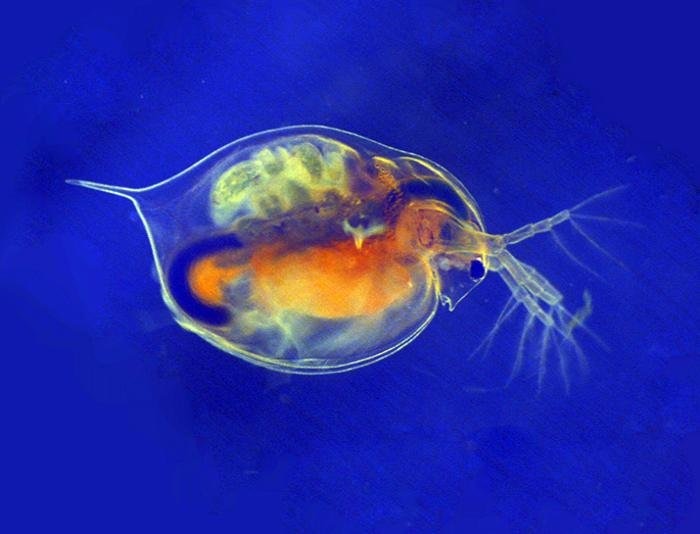Nov 19 2019
According to a new study, treated wastewater contains titanium and silver nanoparticles that may have adverse impacts on crustaceans, algae, and cells of fish gills, and these impacts appear to be dependent on species.
 Exposure to treated wastewater did not have any adverse effects on the freshwater crustacean Daphnia magna. Image Credit: NIVA.
Exposure to treated wastewater did not have any adverse effects on the freshwater crustacean Daphnia magna. Image Credit: NIVA.
Individuals may not constantly think about it when they flush the toilet or do their laundry; however, whatever they wear, eat, or apply on their skin goes into the wastewater and ultimately ends up in the environment. Nanoparticles are increasingly used in consumer products such as personal care products, foods, and textiles.
The nanoparticles are considered unique because of their small size—1 nm is equal to one-billionth of a meter. This small size gives special and innovative characteristics to the nanoparticles when compared to their bigger equivalents; for instance, they may reach locations that cannot be reached by larger particles.
Pristine nanoparticles also act in a different way when compared to the nanoparticles found in the environment. Nanoparticles in the environment are transformed when they interact and form aggregates with other solids, elements, or particles, thus gaining other physicochemical characteristics.
However, the conversion of these small particles in wastewater treatment procedures and their impact on marine and freshwater creatures have mostly remained a mystery.
Increased Mortality of Marine Crustaceans
In a research carried out at the Norwegian Institute for Water Research (NIVA), Anastasia Georgantzopoulou along with collaborators from SINTEF and NIVA analyzed how titanium dioxide (TiO2) and silver (Ag) nanoparticles act in wastewater treatment plants, and how they impact freshwater and marine creatures.
Using sludge from a wastewater treatment plant located in Norway, the scientists created a laboratory-scale wastewater treatment plant and then added environmentally applicable concentrations of TiO2 and Ag nanoparticles over a period of five weeks. They utilized the treated wastewater to evaluate the impacts of the converted nanoparticles on marine and freshwater creatures, and also on the gill cells of rainbow trout.
The experiment revealed contrasting impacts on both crustacean species. While mortality increased by 20%–45% for the marine copepod (Tisbe battagliai), exposure to the treated wastewater did not have any harmful impact on the freshwater crustacean (Daphnia magna).
These differences are probably due, at least partly, to the two species’ different feeding habits, in combination with the fact that the nanoparticles showed a strong association to solids present in the wastewater.
Anastasia Georgantzopoulou, Researcher, Norwegian Institute for Water Research
Georgantzopoulou continued, “Daphnia magna is an organism that filters water for food, whereas the marine copepod feeds on bottom surfaces—like effluent solids that have settled out from the water. The bottom-feeding crustacean is therefore more likely to ingest nanoparticles, and thereby be affected by solid-associated nanoparticles.”
Effects on Algal Species
Moreover, while the treated wastewater containing nanoparticles had an impact on algal growth, the two algae species did not show a common response: while the marine algae (Skeletonema pseudocostatum) responded with a growth inhibition of 20%–40%, the growth of the freshwater algae (Raphidocelis subcapitata) was, in fact, triggered by an increase of 40%, followed by an increased aggregation of cells.
Perhaps, the latter is some sort of a defense mechanism that aims to reduce the surface area subjected to harmful particles.
The results from our study indicate that algal responses to the treated wastewater exposure are species-dependent. This is possibly due to differences in algal cell size, surface area, and cell wall composition.
Anastasia Georgantzopoulou, Researcher, Norwegian Institute for Water Research
Increased Permeability of Fish Gill Cells
With the help of an in vitro gill cell line model, the scientists also observed the effects of Ag and TiO2 nanoparticles on the cells of fish gills. When huge quantities of water are moving through the gills, and they represent an obstacle to the external setting, this organ is largely subjected to water-borne contaminants, such as nanoparticles.
“Exposure to nanoparticle-containing wastewater lead to an increase in reactive oxygen species, a group of molecules that can easily react with and damage cells. This was followed by increased permeability of the gill cells, leading to a compromised barrier function,” added Georgantzopoulou.
“However, the concentrations of silver and titanium nanoparticles in the treated wastewater were too low to fully account for the effects on cell permeability alone. The wastewater effluent is a complex mixture of materials, and the permeability response is probably caused by a combination of the presence of nanoparticles and other stressors,” Georgantzopoulou further added.
Wastewater Treatment—Transformation of Nanoparticles
We carried out this study on wastewater treatment plant-transformed nanoparticles, and compared them to pristine nanoparticles, as the former is more relevant to what is actually happening in the environment.
Anastasia Georgantzopoulou, Researcher, Norwegian Institute for Water Research
Georgantzopoulou continued, “The increased toxicity of the transformed nanomaterials observed in the study indicates that the effects cannot be predicted by assessing the effects of nanomaterials in their pristine form and highlights the importance of understanding their behavior, environmental transformation and interaction with organisms.”
Future studies should take nanoparticle transformation into account and focus on a more relevant experimental exposure conditions incorporating transformed nanoparticles in more long-term impact studies to provide a better understanding of their potential impacts,” concluded Georgantzopoulou.
The study was funded by the Research Council of Norway through Nano-WASTE “Investigating the fate of nanomaterials in wastewater treatment plants; removal, release and subsequent impacts” (Grant Agreement number 238972/O70). The research also received support from the FORURENS Nanoparticle Characterisation in Environmental Media: Linking exposure to effects NANO-CHARM (Research project—MILJØ2015).